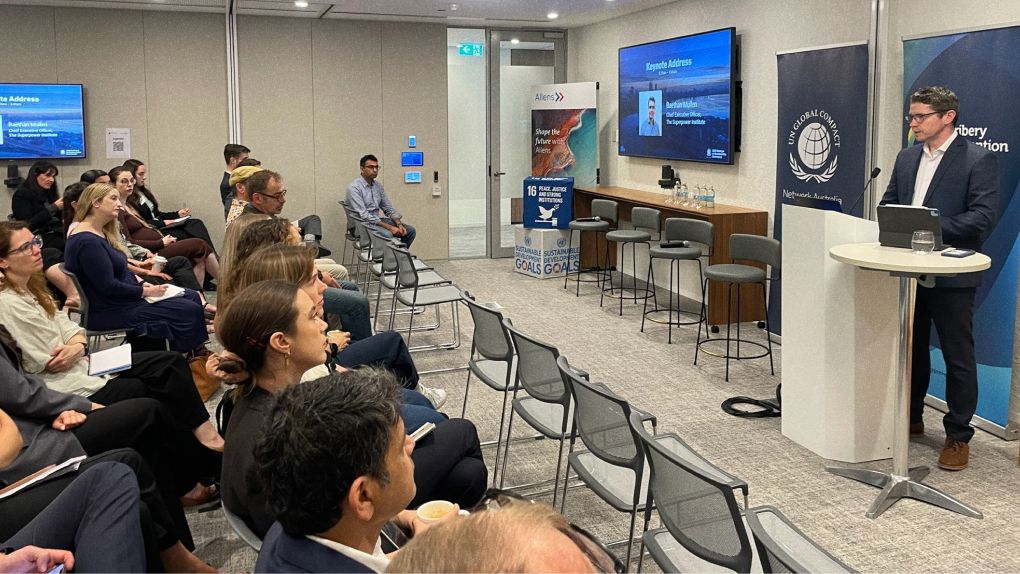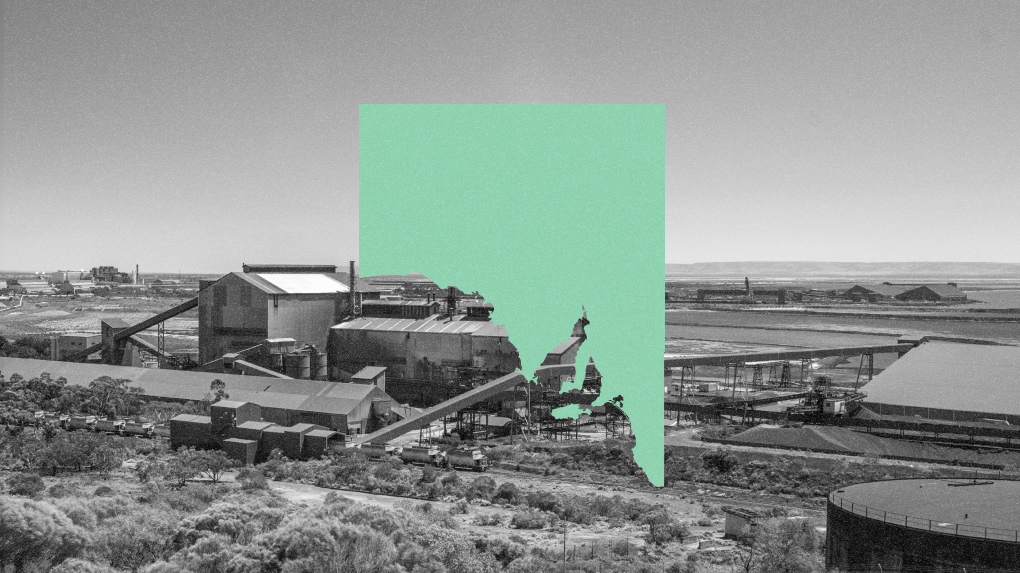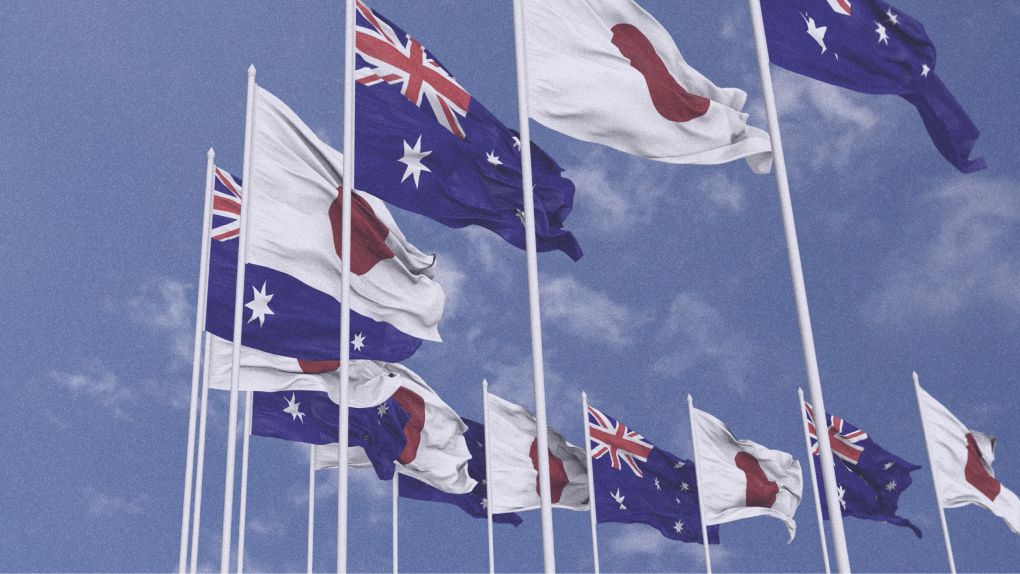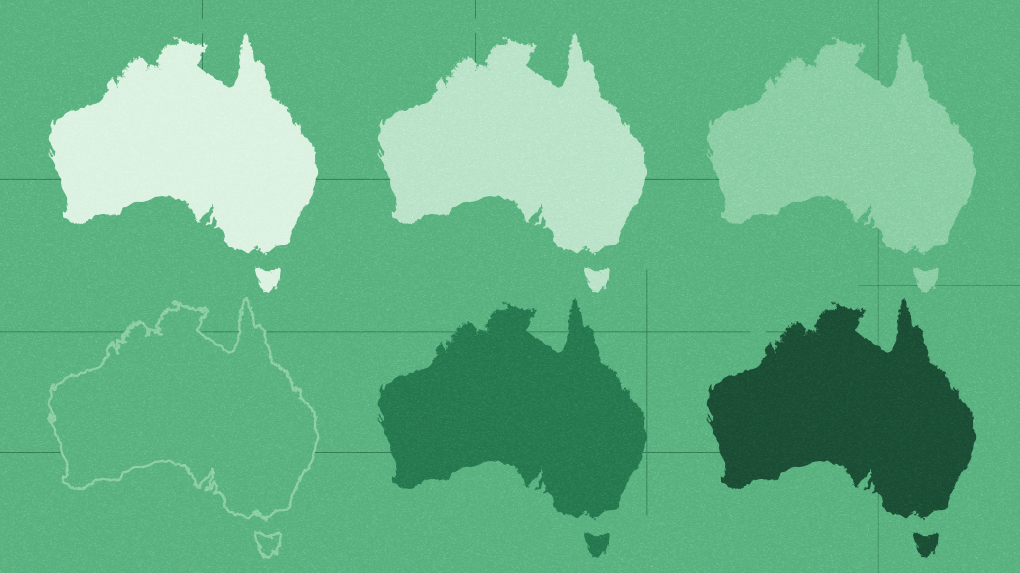Thank you to the UN Global Compact Network of Australia and Allens for the invitation and for organising this important event.
I would also like to acknowledge the Whadjuk Nyoongar people on whose lands we meet today, and pay my respects to their Elders past and present, and to all Traditional Owners across Australia.
It’s exciting that the organisers of this event recognise The Superpower Institute and our work for its strong connection to sustainability governance and the role of ESG in the energy transition.
Today I’d like to talk more about the work we do, why we think our focus is important, and how it frames the broader discussions you’ll have during this event.
This event aims to be a conversation about governance — the rules we set and the trust we build, including safeguarding large scale investments from bribery and corruption — and how those choices will shape whether Australia captures the economic dividends from, and maximises its contribution to, climate change mitigation.
We stand at the dawn of perhaps the most significant industrial development in our nation’s history. This coincides with a time when the world’s capacity to cooperate and collaborate on climate-change solutions is being tested more than ever before.
We also find ourselves at a moment when the diplomatic and trade rules, institutions, and relationships built over decades are being questioned — and in some cases — undermined.
Questions of governance are not abstract — they’re central to whether the transition succeeds.
In today’s geopolitical environment, international trade is increasingly, and very concerningly, being weaponised — used to assert dominance, and pursue domestic prosperity, at the expense of shared global progress.
While it is fair to question whether the existing international trade paradigm will serve us in a decarbonising world, there are some signs the wrong questions are being asked.
And while we have limited capacity to influence who the United States elects as president, we can control how we engage internationally — whether we continue to build on the foundations of international relations that have delivered the prosperity we enjoy today, or retreat into trade protectionism.
Middle powers like Australia gain most when the world plays by the rules — and we suffer most when it doesn’t. That gives us both a stake and a responsibility to defend the institutions that make open trade possible.
Middle powers like Australia gain most when the world plays by the rules — and we suffer most when it doesn’t. That gives us both a stake and a responsibility to defend the institutions that make open trade possible.
This is surely a context in which governance has a key role. Because in periods of uncertainty, effective governance — clear rules, sound institutions, and mutual trust — becomes even more important.
And we can respond to this uncertainty in one of two ways — by closing in to protect what we have, or by leading and helping to shape the rules that will define the next century of trade.
I will return to this theme later after focusing on the superpower concept in more detail.

In a recent speech, Professor Ross Garnaut, co-founder of TSI and eminent Australian economist, called out a common misconception about the pathway to decarbonisation. That is, an assumption that goods that are currently made from fossil carbon will continue to be produced in the same places even as the world decarbonises. The work of TSI is mostly about demonstrating why this thinking is flawed, why a better alternative exists and how we can achieve it.
As Professor Garnaut has pointed out, the modern fossil-fuel trade didn’t appear overnight. It took decades after the Second World War to establish the infrastructure, commercial frameworks, and trust between governments and industry that made large-scale energy trade possible. That system was built on bold public and private investment and long-term cooperation between nations. Much of that experience is relevant again today as the world builds a zero-carbon energy system. But as Garnaut notes, this new phase will also need fresh institutional thinking and major new infrastructure to make it work.
Australia has been here before — identifying new trade opportunities and backing them with bold investments, often ahead of their time and in the face of criticism. From agriculture to manufacturing to mining, the right choices have defined our national prosperity.
And we now find ourselves at a similar juncture. Recognising what is possible and making the right decisions will determine Australia’s prosperity for the next several decades.
Let me set the scene in terms of how we see the Superpower opportunity for Australia. There are two ways to look at it.
The first is the economic lens: what scale of economic activity could this generate for Australia?
To give you something to compare with, Australia’s current iron ore exports are worth around $100 billion per year. The current value of fossil fuel exports - coal and gas - is around $150 billion per year.
By 2050, we estimate Australia’s potential as a green-export superpower could approach $1 trillion annually.
Behind those numbers are communities and workers whose future prosperity depends on how we manage this transition.
This is no small task. It involves the kind of investment we saw during the mining boom but sustained for multiple decades. Indeed, deliberate governance is critical to ensure such significant investments are in the broad public interest - embedding transparency, value for money, equity and justice in the decarbonisation process - as we’ll hear about in more detail today.
The second lens to apply to the Superpower opportunity is an emissions one.
Australia currently represents around 1% of global CO2 emissions. Rightly or wrongly (and I’d argue wrongly) this is often portrayed as insignificant.
Australia’s emissions-reduction potential if we build superpower industries and supply green commodities to the world is far from insignificant. Green iron produced in Australia alone could contribute to nearly 4% reduction in global emissions. Green fuels, another 3%. Add in polysilicon, other green chemicals and fertilisers and in total Australia’s contribution to global emissions reduction can be as high as ten percent.
Green iron produced in Australia alone could contribute to nearly 4% reduction in global emissions. Green fuels, another 3%.
And then there’s critical minerals which are an important focus of today’s agenda.
Critical minerals are similar to iron ore in that Australia’s role to date has been mainly to dig these deposits out of the ground and to ship them in raw form, mainly to China, for processing.
And I look forward to hearing this afternoon from Jennifer Parker at Lynas Rare Earths about their business model as an alternative source of processing and supply.
Unlike iron ore, however, which is important to satisfy existing global steel demand, critical minerals are a growth area by virtue of their increasingly important role in the energy transition.
Lithium, nickel and cobalt in batteries and rare earth elements used in wind turbines and electronics, are just some examples of critical minerals where the ‘superpower’ logic can apply.
The Australian Government estimates global demand for critical minerals will need to increase by 350 percent by 2040 as the world pursues net zero.
Demand for these products and these commodities, is a clear growth market in which Australia can play a major role.
Increasingly governments are also recognising the energy and national security imperative of critical minerals.
As the Australian Treasury has observed:
- Global supply is highly concentrated and vulnerable to disruption
- There is limited capacity for the industry to quickly adapt and respond to any shock, and
- The consequences of a serious supply disruption would be significant.
For this reason, the Future Made in Australia framework has a whole stream dedicated to commodities where:
[quote] ‘...some level of domestic capability is necessary or efficient to deliver adequate economic resilience and security, and the private sector would not invest in this capability in the absence of public investment.’ [end quote]
Treasury also notes that critical minerals may require public support that accounts for the public value of management of geostrategic risk and promotes private investment at scale.
In other words, the case for government involvement is not only economic — it’s also a matter of energy and national security.
Let me return to the logic of superpower trade in some more detail.
You will all be familiar with the way energy trade occurs in the fossil fuel world.
Millions of years of geological development has unevenly scattered fossil fuel resources across the globe. But energy demand does not perfectly map where deposits of coal, oil and gas exist.
Some countries were lucky enough to build societies near to where these deposits were eventually discovered. Others were not so fortunate. But that is not the end of the story. You can still generate electricity by burning natural gas in Northern Europe where there is none in the ground. You can still make steel by burning coal in Northeast Asia where there are no coal mines. And you can still power trains, planes and automobiles with gasoline all over the world, thousands of kilometres from the crude oil wells and refineries.
What makes this possible, of course, is international trade — one of the best examples where real-world outcomes so neatly follow economic theory. I could spend all day celebrating its virtues — but I won’t. I will simply say that international trade, and in particular international trade in energy, has likely been one of the greatest drivers of global development in human history.
Unfortunately, it is also likely to be the biggest threat — of our own making — to the stability of Earth’s climate.
So the question becomes: how can we harness the power of trade — learning from the fossil-fuel era — to drive economic growth while combating climate change?
What we will find is that some things remain the same while others will need to change.
What stays the same is the reality that not all countries are endowed with the same energy resources. Rather than this statement applying to what is in the ground that can be dug up, it now applies to the ability to produce zero-carbon energy — and that principally means renewable energy.
We have all heard, ad nauseam, that the weakness of renewable energy is that it isn’t available when the sun doesn’t shine and the wind doesn’t blow; the so-called ‘dunkelflaute’. For some countries, that’s true more often than not. For others, like Australia, there are regions where it is rarely both windless and dark at the same time.
International trade has always been a great equaliser — allowing countries to consume what they cannot easily produce. The same principle will apply to zero-carbon energy, with one crucial difference.
While trade in coal, gas, and oil is relatively cheap and straightforward, trading electrons — electricity itself — is far more complex. That leaves three main options:
You can build high-voltage transmission lines to transport electricity — at great cost and with significant practical challenges, especially undersea. The result is higher costs for households and reduced competitiveness for businesses.
You could also convert the electrons into a ‘carrier’, like hydrogen or ammonia, ship that product, and convert it back into electricity at the other end. But this results in large efficiency losses — and again, higher prices for end users.
The third option — and the one that economics will ultimately dictate is successful — is to use zero-carbon energy close to where it is produced, processing goods into intermediate forms that can be cheaply and efficiently transported around the world.
To illustrate, let’s consider steel.
Many steel-producing countries have no coal and no iron ore; they import both in very large quantities. They heat the iron ore to very high temperatures, using a blast furnace powered by burning coal, to make iron metal, which is further processed to become steel. The coal and iron-ore inputs are perhaps 50–60 percent of the cost of the steel.
The steel is then processed further to become panels for cars and whitegoods or structural beams used in construction or ship hulls. Many of these products are then exported from the steelmaking country — again, the benefits of international trade on display!
So you can view international trade as a complete cycle. Australia, for example, exports iron ore and coal and imports cars and whitegoods. We are economically better off doing this than trying to manufacture those end products ourselves, because we benefit from scale and innovation in other countries that we cannot easily replicate.
Now let’s take the alternative pathway to producing steel in a low-carbon way.
Instead of exporting the iron ore and coal, the coal stays in the ground. The iron ore is processed using renewable energy — most likely hydrogen, used as a reducing agent — to convert the ore to iron metal. The iron metal, or green iron, can then be shipped in bulk — just like other commodities — cheaply and efficiently.
Australia can lead the world in this kind of green industrial production. We are blessed with the best renewable energy resources on the planet. We have many kinds of raw minerals, including critical minerals, in large quantities. And we have a relatively small domestic demand for both the intermediate and end products. So our capacity to produce far outweighs our need to consume. This is the recipe for Australia to be a Superpower exporter.
Returning to the topic of the day, the opportunity sits before us but realising it will see an important role for governance, particularly in the international trade context.
Domestically, we need to build on the Future Made in Australia framework with greater policy precision: clarifying the government’s role in addressing three market failures:
- Addressing the green premium - the cost gap between green and fossil-based production - with production credits until a system of global carbon prices takes over.
- Incentivising early innovators for the risks they take but for which they are not rewarded.
- Contributing to the building of common user infrastructure that will be used by green industries - electricity transmission, pipelines, water and transportation infrastructure.
Internationally, we must also seek to extend our trusted relationships with long term trade partners in the fossil economy into the zero carbon era. We must also restore the stable order of international trade that has served us so well for the best part of a century.
To conclude, allow me to return to Ross Garnaut who has described the pathway we need to follow in order to succeed.
Professor Garnaut has warned that the greatest danger from the United States stepping back from global cooperation on trade and climate is not simply the loss of its leadership, but the influence its retreat could have on others. When a major power turns inward, others often follow — whether through retaliation or imitation — and the risk is a broader unravelling of both the trading system and the cooperative effort on climate.
We have seen this before. In the 1930s, when leading economies adopted protectionist policies, the effects spread quickly through the global economy and deepened the Great Depression. A similar dynamic today — with countries responding in kind to renewed protectionism or wavering commitment to climate cooperation — would weaken the institutions that have underpinned stability and prosperity since the Second World War.
Our task, then, is to help keep open trade and climate cooperation alive, even if the United States remains uncertain in its direction. That means resisting the urge to introduce new trade discrimination or carbon-related protectionism. It means continuing to support the World Trade Organization and its dispute-resolution role. It means strengthening the UN framework for climate cooperation.
And it means deepening collaboration among those countries that still believe in the value of a rules-based international order — including Canada, the ASEAN nations, Japan, Korea, China, New Zealand, the United Kingdom, the European Union, and the Nordic states — countries committed to sustaining open markets and climate cooperation regardless of shifting global politics. Together, these like-minded partners can help preserve an open trading system and a cooperative approach to decarbonisation, even during a period when the old centre of gravity is less certain.
Our success in this next chapter will rest on the same foundation that has always underpinned Australia’s prosperity — trust in our institutions and confidence in our rules.
Put like that, it doesn’t seem so hard. And if history is any guide, Australia’s best contributions have always come when we’ve backed rules over rhetoric and cooperation over isolation.
Thank you and I hope you enjoy the rest of today’s program.
Baethan Mullen
Chief Executive Officer
Baethan Mullen has over 20 years of experience in public policy, economics and advocacy. Prior to joining the Superpower Institute, Baethan was General Manager of Economics & International at the ACCC, and led the largest energy efficiency program in Australia as Executive Director at the Essential Services Commission.





